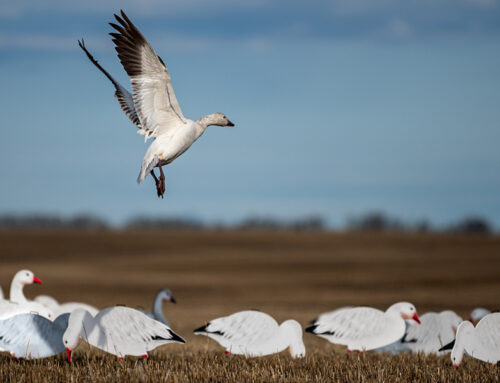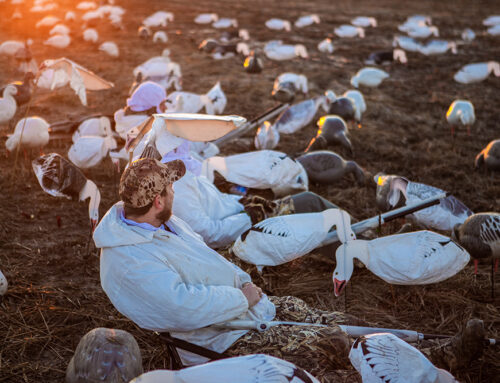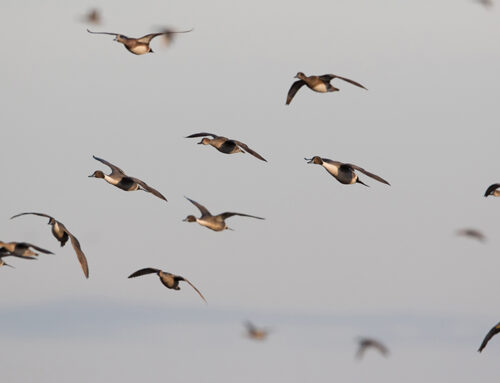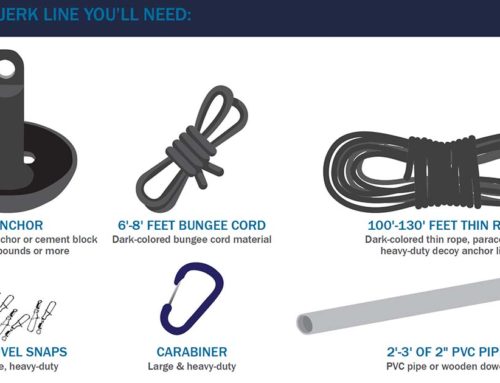The Joys of Coot Shooting

Often ignored by waterfowlers, “mud hens” can turn a dull hunt into one to remember
By John N. Felsher
“Shoot,” I yelled as birds exploded in all directions, running across the water frantically trying to get airborne. “There’s another one just starting to run. Fire! Here comes a straggler. Get him!”
In seconds, my son pumped his brand-new 20-gauge shotgun three times, scoring a double. Fortunately, the birds that flushed didn’t travel far.
 “See those birds flocked up in that cove?” I asked, pointing to where the birds we jumped landed to join several hundred of their cousins. “Let’s paddle behind that island and come at them from the rear.”
“See those birds flocked up in that cove?” I asked, pointing to where the birds we jumped landed to join several hundred of their cousins. “Let’s paddle behind that island and come at them from the rear.”
For the next few hours, we repeated this procedure multiple times. In contrast, we had sat in a duck blind staring at empty skies earlier that morning. Predawn excitement faded into boredom as the sun climbed higher in the sky. While waiting for mallards to swarm us, several coots swam into our pond, and the flock kept growing. Eventually, we couldn’t stand it any longer.
“Wanna break-in that birthday present, son?” I asked, already knowing the answer. “Pick out a coot, but make sure you don’t shoot any decoys. Bust one on the water and then see if you can hit one in the air.”
My son stood up to see over the blind wall and took careful aim at a coot swimming about 25 yards away.
BAM!
 He bowled that one over, making his first kill with his new shotgun. Then, he cartwheeled another coot running across the water as the remaining birds scattered.
He bowled that one over, making his first kill with his new shotgun. Then, he cartwheeled another coot running across the water as the remaining birds scattered.
Coots cannot vault into the air to fly like mallards or other puddle ducks. Not truly ducks, they must use their oversized, lobed (not webbed) feet to patter across the surface to get airborne.
“Good job, son!” I exclaimed. “Two for the pot! Let’s see how quickly you can bag a limit. Unload your gun and sit in the front of the canoe. I’ll paddle from the stern. When we both get situated in the boat, you can reload and wait for action. We’re going to jump some coots.”
Humdrum to Guns Blazing
Almost every waterfowler who ventures into marshes or lakes sees flocks of black water birds that biologists call Fulica americana and Louisiana Cajuns call “poule d’eau.” Some call them mud hens, or other derogatory names.
Whatever people call them, few hunters intentionally target these chicken-like members of the rail family. Although some waterfowlers occasionally pick off coots that fly too closely to the blind, or more likely swim into the decoys, most hunters simply ignore them. However, a good coot shoot can turn a humdrum day into a gun-blazing adventure.
Jumping coots is also an excellent way to introduce youngsters to waterfowling. Children soon grow bored sitting in cold blinds for long hours with little action. On a good day, kids can burn through ammunition quickly while pursuing coots.
 Give ’Em the Sneak
Give ’Em the Sneak
Since coots seldom decoy and won’t respond to calls, you must go looking for them. Federal laws prohibit hunters from shooting at migratory birds from boats under power, including sails and electric motors. Before anyone can shoot, the motor must stop and all forward momentum cease. However, hunters may shoot at migratory birds from boats poled or paddled by human power unless prohibited by local regulations. Some waterfowlers hunt from blinds during the morning and then jump coots after the early flights cease.
Although coots enter brackish or salty systems occasionally, they prefer sweeter water with abundant aquatic weeds. They thrive in freshwater marshes, estuaries, and sluggish rivers with numerous backwaters and large lakes. They even land in golf course water hazards, water treatment ponds, stock tanks, irrigation ponds and aquaculture impoundments.
Coots habitually raft by the thousands on major reservoirs and estuary bays where they can see danger coming from great distances. Although rarely hunted, coots do become nervous when a boat slowly approaches them in open water, often swimming frustratingly just out of range.
Canoes and kayaks can enter many places where larger boats cannot go. Coot shooters should stick to reedy shorelines, isolated backwaters and broken marshes pockmarked by ponds and sloughs. Even on major reservoirs, coot hunters can usually find isolated creek channels, coves or backwaters that could provide good jump shooting.
Staying Stealthy
To avoid detection, glide along quietly hugging shorelines. Ease paddles into the water. In shallow, hard-bottomed areas, use paddles almost like push poles, sculling along without lifting them from the water. Dripping water can alert birds because sound travels long distances over water, especially on still mornings.
When practical, keep islands, tall canes or other cover between the boat and the birds. Bends in winding channels make great ambush points because they limit visibility. Quietly take the inside curve on any bend to keep hidden as much as possible. As a boat rounds a bend, a large flock could erupt from a weedy shoreline only yards away.
Pay particular attention to weedy, broken shorelines with numerous points, pockets and other irregularities. Believing themselves hidden, coots commonly remain in those pockets and don’t move even as boats slowly drift past them. Also watch for movement, feathers, loose floating weeds or other signs that could indicate coot activity. Listen for their calls or the sound of running feet splashing water.
When spooked, coots usually prefer to swim or run across the water to escape danger rather than fly. When coots run across the water, they kick up white splashes that can be seen from long distances. Runners make great targets as they patter across the surface. Even after getting airborne, coots usually fly low and regularly land quickly, maybe just around the next bend. After dispatching cripples and picking up kills, take a break to let the flock settle down for a few minutes. Then, make another stalk. In a good area, paddlers can often sneak up on the same birds several times.
Loaded for Coot
On big waters, shots typically come at extreme ranges. Hunters should use a tight steel-safe choke with No. 2 steel or No. 4 of a denser non-toxic load. When jumping coots in marshy sloughs where shots typically come at shorter ranges, use a modified or improved cylinder shotgun loaded with No. 4 steel or Nos. 6 or 7½ tungsten or bismuth.
When paddling solo, hunters can place their guns across their laps or in another convenient, safe place for easy access when targets appear. For the best results, hunt in teams. Designate one shooter to sit in the bow ready for action while the other person in the back paddles and acts as spotter.
Smiles All Around
Contrary to popular belief, coots make a delicious meal that can be prepared in several ways. Many people skin them and split the meat into in halves or quarters. Others simply fillet out the breasts into boneless chunks. In addition to the meat, some folks fry the enormous gizzards.
Coot season normally runs concurrent with duck season, but coots do not count in the daily duck limit. Widespread, super abundant and seldom hunted, a limit of coots and a hot gun barrel could put a big smile on any youth’s face, or even that of an older, experienced hunter — particularly when mallards don’t fly.
John N. Felsher shares the joys of hunting from Eight Mile, Alabama.






As our domestic population swells well beyond a manageable level and subsequently wetland habitat vanishes, those who continue to think of themselves as waterfowlers will again need to re-invent opportunity. So as the sport changes the sanctuary of the lowly pouldeaux must now be invaded…
Great article! Nothing like a good coot shoot on a stale day in the marsh.
How did I know you would love this write up.
Would have liked to see a recipe or two. I don’t kill what I won’t eat and I hear they got they got the name “mud hens” because of the taste.
I don’t know any good recipes because I can barely make cereal in the morning, but I’ve eaten coot prepared many different ways and loved them all. Many people split them in quarters and grill them, put them in gumbos or fry them. Some people cut them in half and roast or bake them. Some people just filet off the breasts to make boneless nuggets and cut off the legs. These are good fried, grilled or put in something with a thick sauce or gravy. Some people fry the huge gizzards. I personally don’t like any kind of organs from any birds or animals, but some people love coot gizzards. Clean out all the stuff inside first! Shoot a few and try them in your favorite ways to cook duck, rabbit or squirrel and see for yourself. Hope you enjoyed it and thanks for reading. John N. Felsher
Something aboot shooting a bird on the water leaves a bad taste in my mouth. Doesn’t seem very sporting.
Great way to Introduce the art of shooting ducks to new youth or even an adult who has never duck hunted before. It may be bad mojo to the seasoned waterfowlers, but give them a break. They have to start somewhere and it’s perfect to get use to shooting the gun and seeing how the shells pattern out of the barrell on the water that sparks an excitement for them. Eventually they will get the hang of it and get those flyers. Great article.
Coot shooters are wanna be duck hunters. The coots are confidence decoys for the real ducks
I’m 12 and last year I shot 79 coot so I guess a kid who also shot over 40 ducks including shooting two birds out of the air in one shell on two different occasions is a wannabe duck hunter. I would also like to mention that I shot three teal and one mallard while coot hunting.
[…] blinds, shore blinds, bush blinds, and layout boats are just a few of the hunting options. Duck and coot hunting is legal in a 6,120-acre area of marsh that is governed by state and federal […]